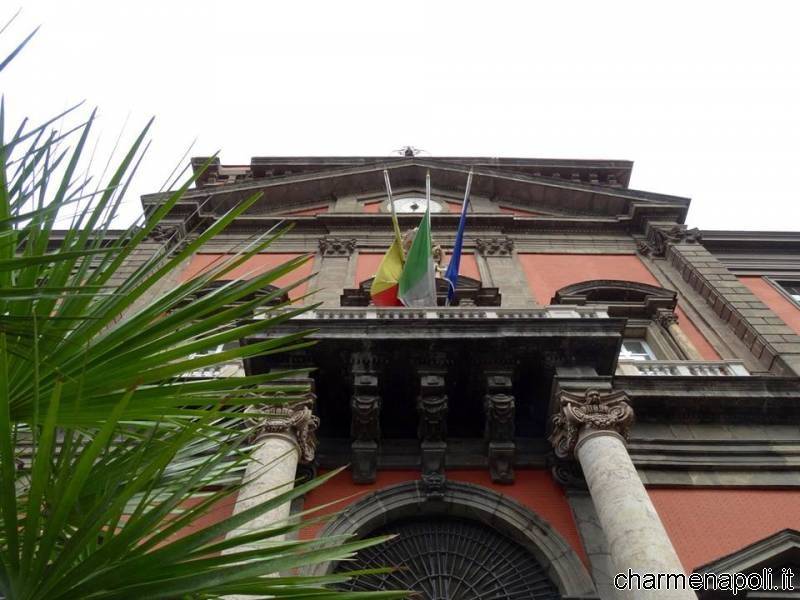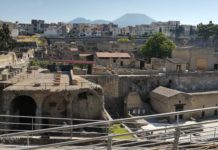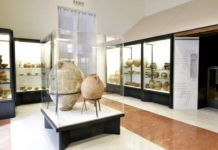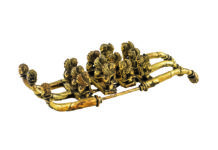History tells us that the National Archaelogical Museum of Naples was built to host the museum since its origins. This is revealed by its foundations, which lay on the Ancient Greek necropolis of Santa Teresa. Nowadays, thanks to the collections and the huge amount of antiquities kept in its vaults, it is one of the most important cultural sites in the world, open to the many tourists visiting Naples.
The monumental building along Carlo III Square was built at the end of the XVI century as a cavalry barrack by the command of the Vice King of Spain (only the mighty portal in piperno that opens onto the west side of Santa Teresa street survives today). During the XVII century it was enlarged, thanks to the work of the architect Giulio Cesare Fontana, and transformed into a university, which remained there for a century and a half, until 1777 when King Ferdinand IV decided to relocate it into the Real Boarding School of the Savior. The seventeenth-century Palace of the Studies was then destined to the first Bourbon Museum and the Royal Library of Naples.
Naples, capital of the Kingdom of the two Sicilies, was the proud holder of its own museum like all the other capital cities of the Old Continent. A prestigious School of Art, a large collection of books and antiquities, once belonged to Elizabeth Farnese (mother of Charles III, the founder of the Bourbon dynasty) and divided between Rome and Capodimonte were merged into a single building.
As the years went by, the elegant and monumental halls of the National Museum have also hosted the various and numerous archaeological collections and the many artefacts that had come to light during the excavations, started in 1738 after the discovery of Herculaneum and Pompeii, that the Bourbons had undertaken in the cities of the Vesuvius buried by the fury of the volcano: amphorae, statues, sculptures, jewelry, bronzes and rare paintings.
As if that were not enough, the pearl of the Bourbons had also been able to acquire, over time, a rich and renowned Egyptian collection, which in Italy is considered, in order of importance, second only to the Egyptian Museum of Turin. However, other sections of the museum shine for the presence of private artefacts, gained by or donated to the city of Naples in the course of its history, like, for example, the Borgia, Santangelo, Stevens and Spinelli coll ections.
To date, in the middle of the third millennium, the Archaeological Museum of Naples can boast the biggest assets of coins, works of art and artefacts of archaeological interest in Italy. Over three thousand valuables exposed in its rooms. Thousands of finds dating from prehistoric times to the times of Ancient Greece, ready to be offered to the enchanted gaze of tourists and visitors. One more reason to enjoy a trip back in time, carried away in the timeless magic of the treasures and museums of Naples.
(translated by Mauro Di Fenza)
Museo Archeologico Nazionale
Piazza Museo Nazionale, 19, 80135 – Napoli
Tel. +39.081.4422149
http://cir.campania.beniculturali.it/museoarcheologiconazionale
Open hours:
Daily: 9:00 to 19:30 (start of operations to remove: 19.00).
Closed day: Tuesday
Closed on festive: 1st January, 1st May, 25th December
Ticket:
Full: Є 8.00 with increases in cases of national and international exhibitions)
Reduced: 4,00 Є for EU citizens between 18 and 24 years, and for teachers of the European Union
Free: Admission is free for EU citizens under the age of 18 years old and over 65.
Combined ticket: Circuit Naples Archaeological and Campi Flegrei: full Є 8.50, reduced Є 4.25, valid for 3 days to 5 sites: the National Archaeological Museum of Naples, Museo Archeologico dei Campi Flegrei (Bay), Ruins of Bay, Flavian Amphitheatre and macellum in Pozzuoli, Cuma archaeological Park.
The Museum is part of the circuit Artecard of Campania

 Italiano
Italiano














